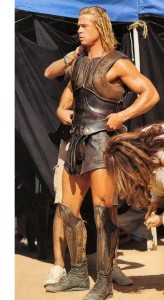The upcoming Hercules movie, starring Dwayne “The Rock” Johnson, looks like it could be one of those rare sword-and-armor flicks worth a watch. Don’t get your hopes up, history geeks- it looks about as historically accurate as most of its predecessors (which is to say, not at all).
But the epic nature of these stories, often filled with emperors and gods, is hard to resist. And the armor that encases our protagonists is a large part of their mystique.
The costuming of armor has been serious business for generations of movie makers. Back to Richard Burton’s 1963 Marc Antony in Cleopatra and Harry Hamlin’s 1981 Perseus in Clash of the Titans, armor has made ancient heroes just that little bit more heroic.
On one end of the spectrum is Gladiator, which dominates our hearts when it comes to heroes in Roman armor. It’s easy to brush off any historical inaccuracies in a movie that’s already full of impeccable (and ambitious) costuming. So impressive was the portfolio of costumes that the film (and the designer, Janty Yates) won an Academy Award for Best Costume Design that year.
Notably, this movie saw some of the most accurate portrayals of Roman armor in big-budget films to date. The appearance of the Lorica segmentata, Lorica hamata, and Lorica squamata- traditional Roman styles of armor- gave the film a sense of legitimacy that previously attempted films had lacked.
To less success, Troy brought very little historical accuracy to the Greek side of armor costume. Brad Pitt and Eric Bana certainly pull off their armor dashingly, sure, but the appearance of iron-looking or thick leather armor is incorrect. (Bronze age, bronze armor!) Given that Hercules shows Dwayne Johnson sporting similarly shiny iron-esque armor, and given that Hercules would have lived long before the time of Achilles, it’s safe to assume that scholarly precision is not the film makers’ foremost goal.
Of course, The Legend of Hercules, starring Kellan Lutz, was released this January to truly abominable reviews (3% on Rotten Tomatoes). The stylized armor used for Lutz’s Hercules was beautiful and iconic, but also incredibly bland. It’s crafted marvelously and says precisely nothing about the character. (Though, given what those screenwriters did to the actual legend of Hercules, that might be for the best.)
Credit where it’s due, neither of this year’s Herculean efforts skimp on the most important piece of Hercules’ armor- the lion skin. This is the trophy that he earns himself after completing the first of his labors of atonement, slaying the Nemean lion. In both iterations, it’s dutifully draped across his shoulders for the movie posters, implying that he has either completed the labors by the time of the film or will do so.
By comparison to many of the ornate, beautifully costumed movies that draw on Greco-Roman inspiration, this upcoming Hercules looks to be favoring gritty realism. We’ll see if the plain and unpolished steel of his armor, dinged and scratched, will reflect the tone of the film. With any luck, it will respect its legendary source material of myths, if not its historical roots.
Hercules releases this week, July 25th.













